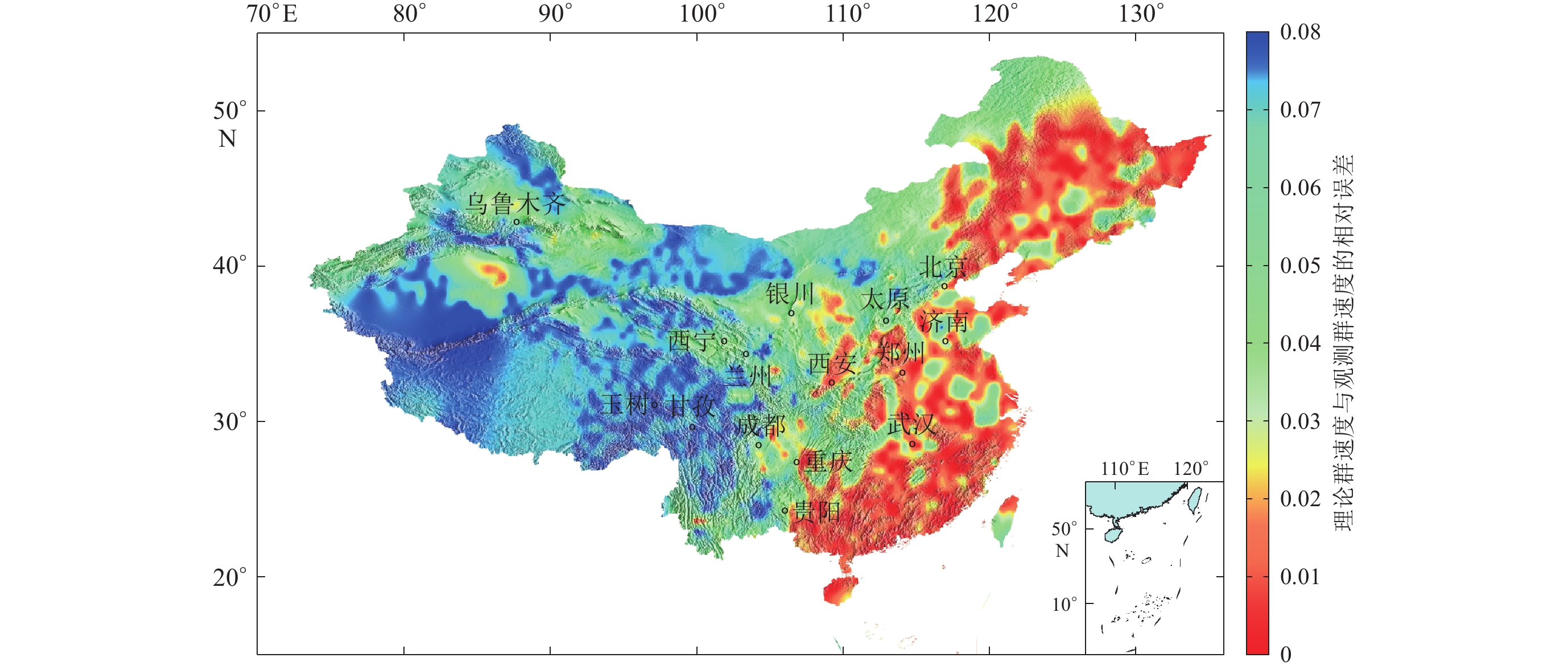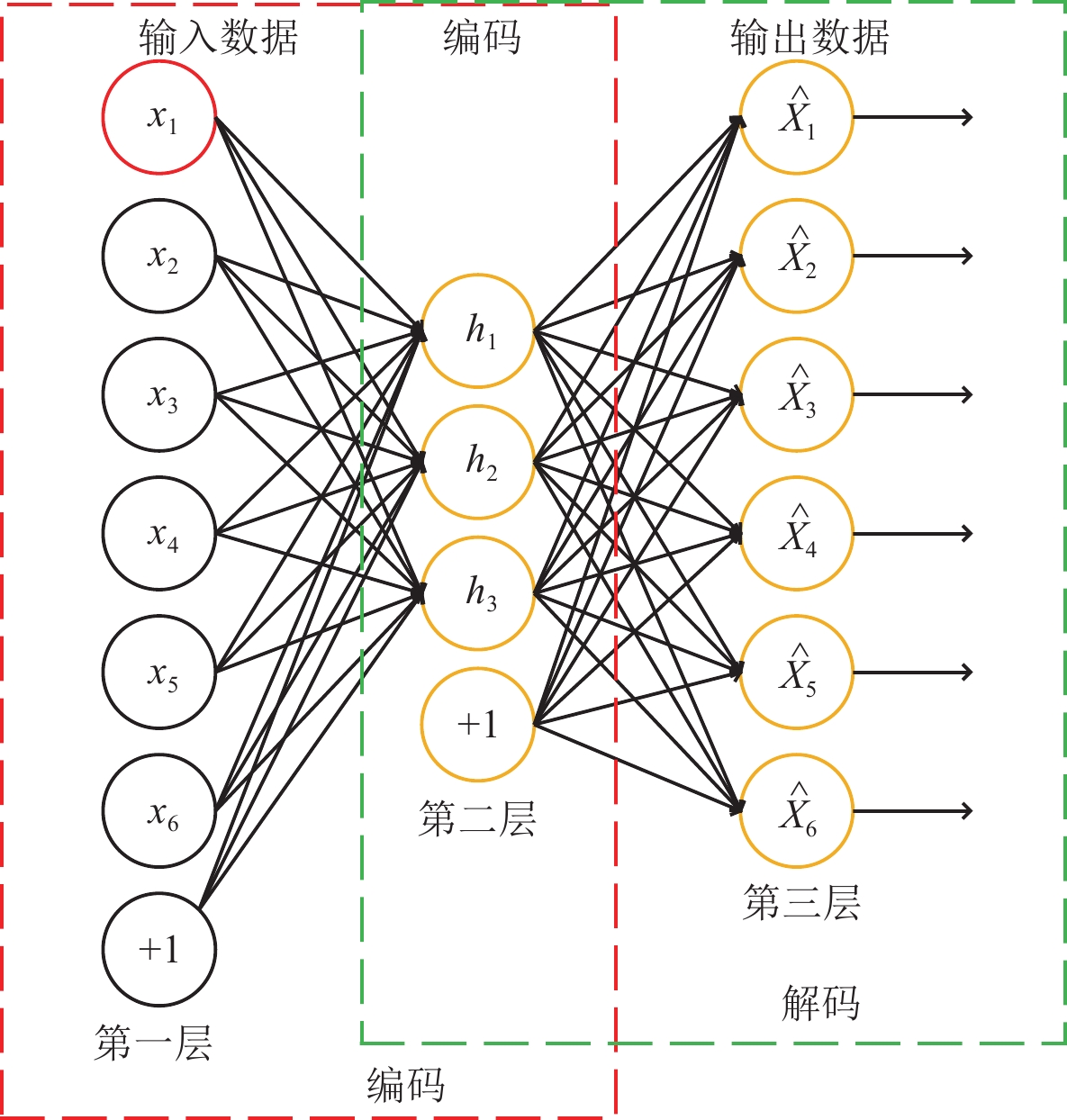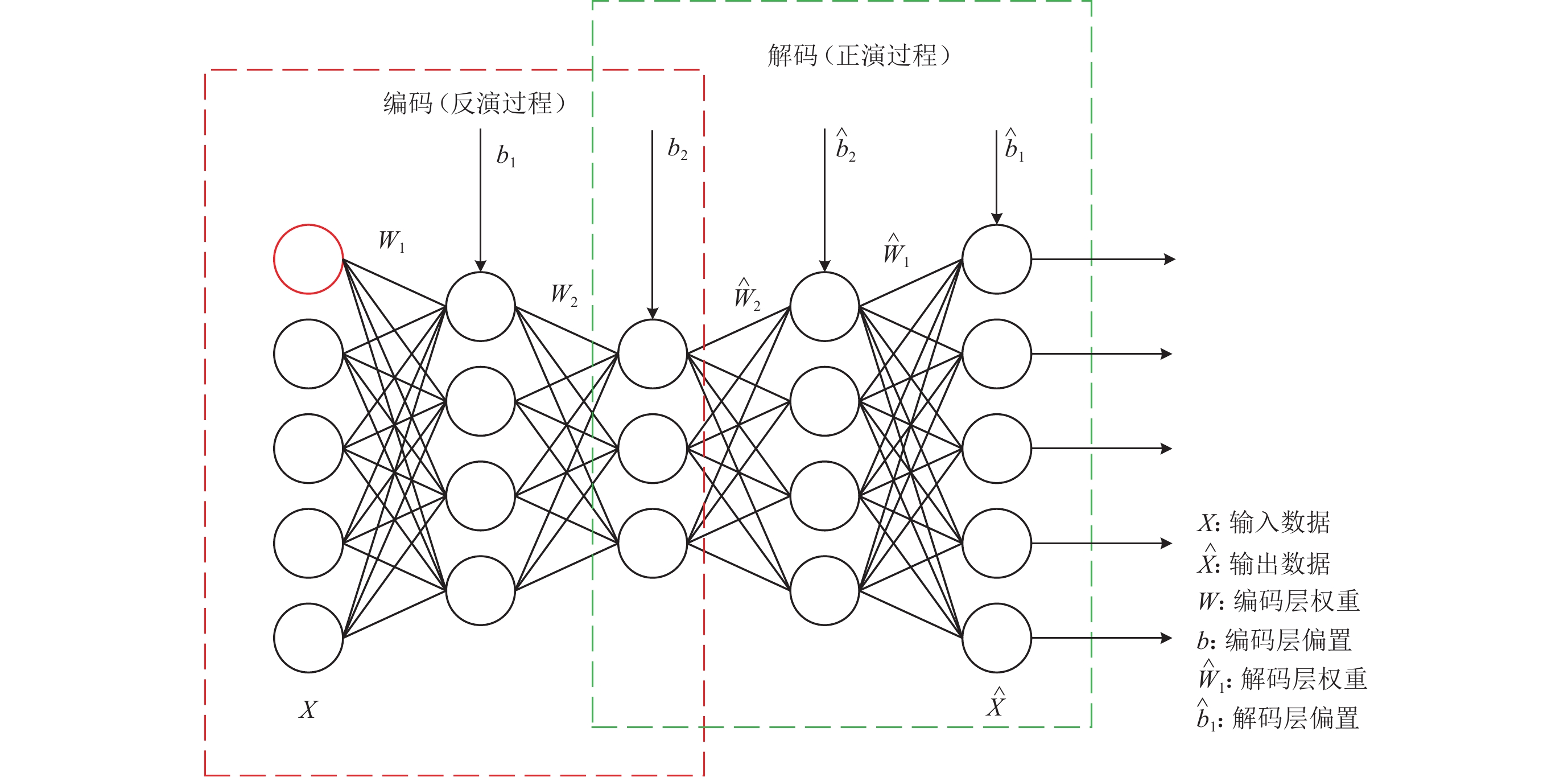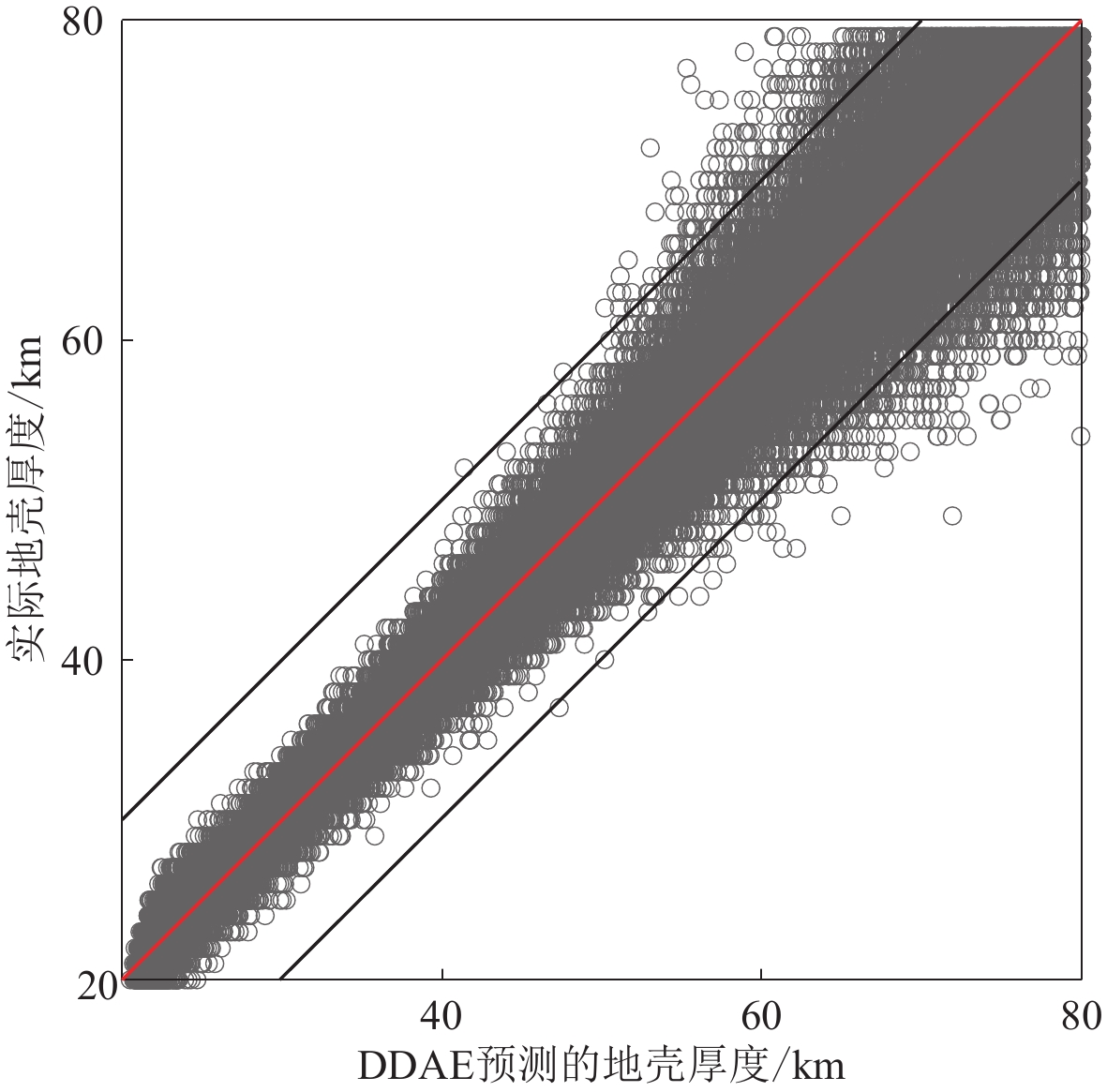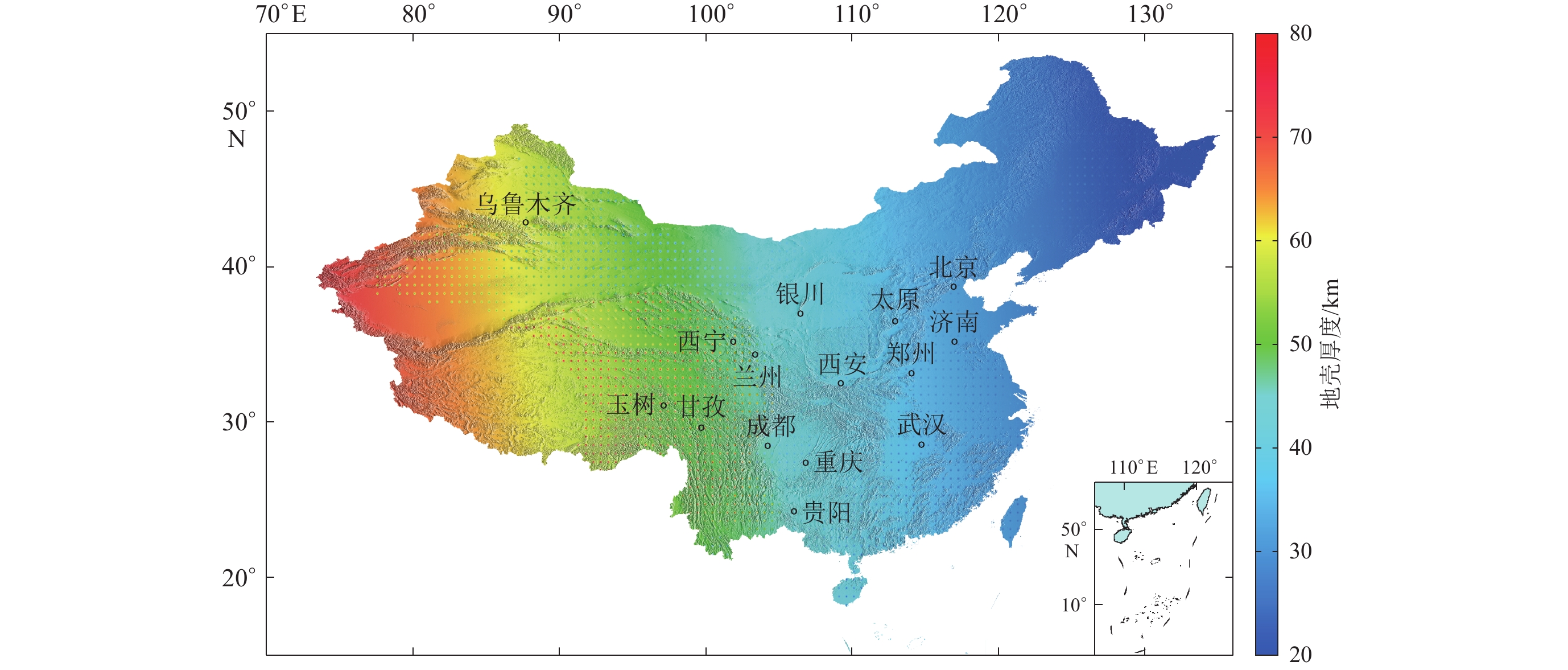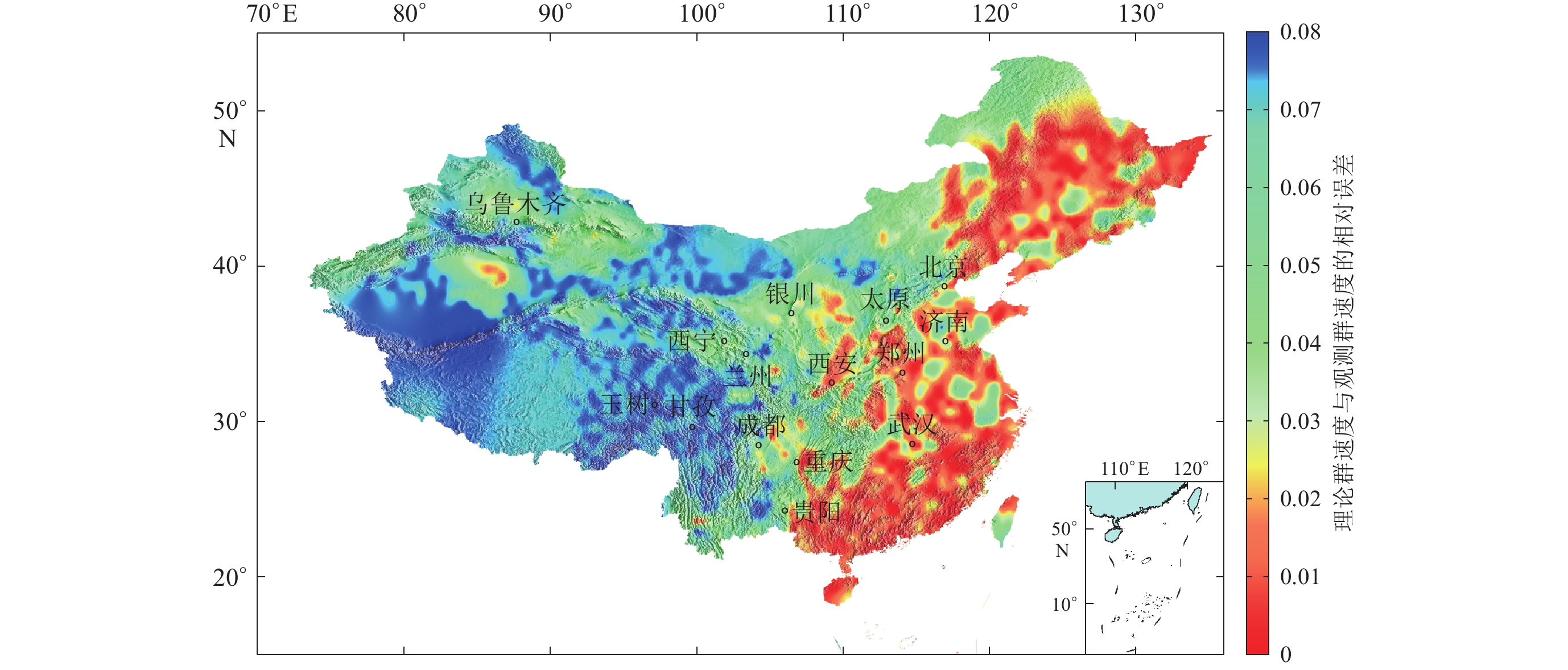Inversion of crustal thickness in Chinese mainland based on deep denoising autoencoder neural network
-
摘要: 本文采用基于数据驱动的深度降噪自编码网络构建了瑞雷面波群速度、相速度频散特性与地壳厚度的正反演函数关系,并利用最新频散模型反演了中国大陆的地壳厚度。对于神经网络架构体系的评价,除了考虑传统意义上的测试误差、训练误差之外,本文还用已知物理原理的正演结果与网络预测结果进行比较;在设计网络构架时,同时考虑地球模型和面波频散的正反演问题,即解码过程对应正演过程,编码过程对应反演过程。另外,针对观测频散数据包含噪声的特点,对训练样本加噪声,使解码器解码出无噪声输入,以达到对观测数据降噪的目的。对网络各种参数多次调试、分析再优化组合,最终获得稳健的神经网络,并据此反演出中国大陆的地壳厚度。本研究结果与已有的不同手段得到的地壳厚度模型的吻合度较高,表明深度降噪自编码神经网络能很好地揭示面波频散与地壳厚度之间的非线性关系,是利用面波频散反演地壳厚度的一种可行的和可信的方法。Abstract: Chinese mainland is a composite continent composed of many micro-blocks, fold belts and orogenic belts after evolution over a long geological period. Chinese mainland crust is of complex crust-mantle structure, and crustal thickness is one of the most important parameters. At the same time, Rayleigh surface wave group velocity and phase velocity have strong constraints on the crust and upper mantle structure. In this paper, a data driven, named deep denoising autoencoder (DDAE) neural network is used to explore the relationship of forward and inversion between Rayleigh wave group velocity and phase velocity and crustal thickness, and we invert the crustal thickness of Chinese mainland by the latest dispersion model. In this paper, the evaluation of neural network architecture is put forward. In addition to the traditional test error and training error, it is compared with the result of network prediction with the forward process of the known physical principles. When designing the network architecture, the forward and inverse problems of the earth model and the surface wave dispersion are considered simultaneously, that is, the corresponding forward process is decoded, and the encoding process corresponds to the inversion process. At the same time, in view of the noise characteristics of the observed dispersion data, the training sample is polluted by noise, so the decoder decodes the noise-free input to denoising the observed data. After debugging, analyzing and optimizing the various parameters of the network, a robust neural network was finally obtained, and the crust thickness of the Chinese mainland was reproduced accordingly. The results of this study are in good agreement with the crustal thickness models obtained by different methods, suggesting that the deep denoising autoencoder neural network can well reveal the nonlinear relationship between surface wave dispersion and crustal thickness, and it is a feasible and credible method to solve the problem of surface wave dispersion inversion for crustal thickness.
-
Keywords:
- deep learning /
- denosing /
- autoencoder neural network /
- Chinese mainland /
- crustal thickness
-
引言
青藏高原地质构造复杂,地质、大地测量及地震构造等研究普遍表明,青藏高原内地壳变形分布广泛:高原内中部地壳主要沿着汇聚方向东西缩短,南部地壳向东西方向伸展,中北部及东部地壳向东部挤出,与云南和缅甸接壤的东南缘地壳向东南或正南方向挤出并在喜马拉雅东构造结处发生顺时针旋转(Molnar,Tapponnier,1975;Holt et al,1991;Wang et al,2001;Zhang et al,2004)。青藏高原内分布有大量断裂带,构造活动丰富,地震频发(Yin,Harrison,2000;邓起东等,2014;叶卓等,2018)。地震层析成像和大地电磁探测等成果均显示青藏高原中下地壳存在低速区(Yang et al,2012;Jiang et al,2014;Bao et al,2015)和高电导率区(金胜等,2010;Bai et al,2010),这表明中下地壳可能处于部分熔融状态(Chung et al,2003;Le Pape et al,2012;Long et al,2015)。作为青藏高原主体的中东部地区,从北到南依次分布着柴达木地块、巴颜喀拉地块、羌塘地块和拉萨地块,是研究青藏高原形成与演化的重要区域,也是研究高原中下地壳低速区成因和分布特征的重要区域。研究该区域地壳和上地幔顶部的速度结构和物性特征,可以推断青藏高原的物质迁移和地壳形变机制,对于理解大陆碰撞机制和生长过程具有重要作用,因此研究青藏高原中东部地壳和上地幔顶部的速度结构特征具有十分重要的意义。此外,青藏高原中东部的地震观测数据丰富,地震事件分布相对均匀,为层析成像提供了有利条件。
近年来,除了利用GPS (Chen et al,2000;Allmendinger et al,2007;Hao et al,2016)和InSAR (李鹏等,2013;Garthwaite et al,2013;Zhao et al,2016)等方法对青藏高原中东部进行地表观测研究之外,研究人员对青藏高原乃至整个中国大陆进行了大量的地震波层析成像工作,例如,Pn波层析成像(Liang,Song,2006;黎源,雷建设,2012)、S波层析成像(Mechie et al,2012;黄忠贤等,2013)、远震或近震P波层析成像(Zhang et al,2012;Lei,Zhao,2016)、背景噪声及地震面波层析成像(Yao et al,2006;Ceylan et al,2012;范文渊等,2015;Pandey et al,2015;钟世军等,2017)和全波形层析成像(Chen et al,2015,2017),取得了很多有意义的研究成果,其中近震P波走时成像仍是地震层析成像的重要手段。传统的近震P波层析成像方法主要是采用地壳P波和上地幔顶部Pn波分别反演的策略,这样可以避免莫霍面对地壳速度结构的影响,但是却容易造成部分高质量数据的浪费。尤其在Pn波层析成像中,忽略地壳横向非均匀性的影响可能会对构造复杂地区(青藏高原等)的反演结果带来较大误差(Li et al,2017),而使用Pn和Pg震相走时联合反演的方法能减小这种误差,取得较好的成像结果(Xu,Song,2010;Huang et al,2013)。为此,本文提取研究区域内1991—2017年地震事件的初至波走时信息,拟利用Pg和Pn波震相走时联合反演方法,对青藏高原中东部的三维P波速度结构进行层析成像,以期得到该地区的地壳P波速度结构、上地幔顶部Pn波速度结构及地壳厚度信息。
1. 数据和方法
1.1 数据选取
我们从美国地震联合会(Incorporated Research Institutions for Seismology,简称IRIS)数据中心收集了青藏高原中东部(88°E—100°E,25°N—40°N)从1991年到2017年共6 617个地震事件的波形记录。为保证数据质量,进行数据筛选,标准如下:① 震级ML≥2.5;② 震源深度d<60 km;③ 震中距≤12°。图 1给出本文所使用的地震台站分布及相应的台网代码和观测周期。
采用Sacpick自动拾取方法,基于地震波形数据对初至波走时进行拾取,具体流程如下:① 根据预设模型计算生成初至波理论走时t;② 根据理论走时选取一定的噪声窗口和信号窗口,本文选取噪声窗口为[t-40 s,t-10 s],信号窗口为[t-20 s,t+10 s];③ 通过滑动窗口寻找振幅发生变化的信号并计算信号窗口与噪声窗口的均方根(root mean square,缩写为RMS)比值,当两者之比大于某一预设值(本文预设值取为5)时,认为该信号有效并予以采用。
本文通过对245个台站记录的1 776个地震事件的地震波形进行自动拾取,最终得到1万4 484个初至波到时数据。图 2给出了2008年12月18日某地震事件初至波自动拾取的示例,可以看出,采用自动拾取走时方法能够将信噪比差的数据直接剔除,保留高质量的数据,并且有效地减少走时拾取中的人为因素,使拾取的走时具有较好的一致性。由于拾取到的到时数据为初至波走时,并非具体的Pg或Pn震相走时,因此在层析成像的每次迭代反演中,还需要分别计算Pg波和Pn波理论走时,并将其与观测走时进行对比,实现初至波震相的判别。
1.2 方法步骤
采用Xu和Song (2010)提出的联合Pg和Pn震相走时反演方法,对Pg波和Pn波走时采用不同的计算方法。在球面坐标系下,利用伪弯曲射线追踪方法(Koketsu,Sekine,1998),Pg波从震源j到台站k的走时残差为
${r_{jk}} = t_{jk}^{{\rm{obs}}} - t_{jk}^{{\rm{pred}}} = \sum\limits_{i = 1}^n {\left({ - \frac{{{\rm{d}}l}}{v}} \right){{\left({\frac{{\Delta v}}{v}} \right)}_i}}{\text{,}}$


(1) This page contains the following errors:
error on line 1 at column 1: Start tag expected, '<' not foundBelow is a rendering of the page up to the first error.
Pn波从震源j到台站k的走时残差为
${r_{jk}} {\text{=}} t_{jk}^{{\rm{obs}}} {\text{-}} t_{jk}^{{\rm{pred}}} {\text{=}} \sum\limits_{{{m}} {\text{=}} 1}^{{n_1}} {\left({ {\text{-}} \frac{{{\rm{d}}l}}{v}} \right){{\left({\frac{{\Delta v}}{v}} \right)}_{{m}}} {\text{+}} } \sum\limits_{{{e}} {\text{=}} 1}^{{n_2}} {\left({ {\text{-}} \frac{{{\rm{d}}l}}{v}} \right){{\left({\frac{{\Delta v}}{v}} \right)}_{{e}}} {\text{+}} \sum\limits_{{{r}} {\text{=}} 1}^{{n_3}} {\left({ {\text{-}} \frac{{{\rm{d}}l}}{v}} \right){{\left({\frac{{\Delta v}}{v}} \right)}_{{r}}} {\text{+}} } \eta \Delta {h_k} {\text{+}} \Delta {t_j}}{\text{,}} $


(2) 式中,等号右边第一项为射线沿莫霍面滑行的走时,第二项为震源端地壳部分走时,第三项为台站端地壳部分走时,第四项η∆hk为台站端莫霍面深度变化引起的走时变化,其中
$\eta = \sqrt {{{\left({\dfrac{1}{{{v_{\rm{c}}}}}} \right)}^2} - {{\left({\dfrac{1}{{{v_{\rm{m}}}}}} \right)}^2}}$


(3) 为垂直慢度,vc和vm分别为该处地壳Pg波速度和Pn波速度,第五项Δtj为震源延迟项。
This page contains the following errors:
error on line 1 at column 1: Start tag expected, '<' not foundBelow is a rendering of the page up to the first error.
2. 计算结果
2.1 一维模型和参数化
由于本文研究区域与Xu和Song (2010)一文研究区域的地理位置比较靠近且东部有部分重叠,为减少反演迭代次数,在计算一维模型时参考其一维P波速度模型,将该模型作为初始地壳速度模型。通过走时数据拟合,得到Pn波平均速度约为8.08 km/s,地壳平均厚度约为55 km。将一维速度模型中地壳的最后一层延伸至55 km深度,得到初始一维速度模型,地壳模型均匀分层,每层厚度为10 km,最后一层划分至55 km (即莫霍面深度处)。采用Pg波和Pn波震相走时联合反演方法确定最终一维速度模型,经过7次迭代反演后残差不再明显降低,此模型即为后续层析成像所使用的一维速度模型(图3)。
采用计算得到的一维速度模型,利用所有初至波走时数据进行三维联合反演。反演采用的地壳速度水平网格、Pn波速度水平网格和莫霍面深度网格的大小均为0.5°×0.5°。联合反演中,震相判别时Pg波和Pn波两者理论走时与观测走时之差的绝对值均小于1 s的数据将不予采用,以减少由于模型粗糙所造成的震相误判,且在计算中要求参与反演的射线走时残差不大于3 s,以防止少量数据对模型造成过大影响。每次迭代结束后,更新模型进行下一次迭代反演。
2.2 残差和分辨率
本次联合反演的初始数据共1万4 484个初至波走时,最终参与反演的射线有1万零444条,射线基本覆盖了研究区域(图4)。
经过8次迭代后,残差不再明显降低,得到联合反演的最终结果,反演后走时残差的分布有一定改善(图5a),但并不十分显著,说明本文采用的初始模型与本区域的真实速度结构比较接近,即Xu和Song (2010)的地壳模型对于本文研究具有较好的参考意义。除震中距大于10°的区间射线数量不足外,反演后各震中距区间的走时残差标准差(图5b)均在一定程度上有所降低,反演后走时残差分布更集中(图5c),走时残差的RMS由初始模型的1.50 s降低至1.21 s,同时参与反演的射线折合走时分布较为均匀(图5d),模型拟合得较好。
![]() 图 5 联合反演的残差分析和走时分布(a) 反演前后走时残差随震中距的分布;(b) 反演前后各震中距范围内走时残差的标准差分布;(c) 联合反演前后走时残差数量分布及其高斯分布拟合曲线;(d) 折合走时(t−d/0.065)分布Figure 5. Residual analysis and travel time distribution of joint inversion(a) Travel time residual distribution before and after inversion;(b) Standard deviations of travel time residuals with different epicentral distance before and after inversion;(c) Histogram of residuals and its Gaussian distribution fitting before and after inversion;(d) Reduced time by 0.065 degree per second
图 5 联合反演的残差分析和走时分布(a) 反演前后走时残差随震中距的分布;(b) 反演前后各震中距范围内走时残差的标准差分布;(c) 联合反演前后走时残差数量分布及其高斯分布拟合曲线;(d) 折合走时(t−d/0.065)分布Figure 5. Residual analysis and travel time distribution of joint inversion(a) Travel time residual distribution before and after inversion;(b) Standard deviations of travel time residuals with different epicentral distance before and after inversion;(c) Histogram of residuals and its Gaussian distribution fitting before and after inversion;(d) Reduced time by 0.065 degree per second由于DLSQR方法求得的结果无法得到方程解的误差矩阵,因此采用检测板测试(Lévěque et al,1993)对反演结果的可靠性进行分析。本文采用与实际数据反演相同的参数设置,对速度模型添加±4%的扰动,并通过反演进行恢复成像。通过多次试验,在网格大小为1.5°×1.5°时速度恢复情况较好,而边缘部分地区由于射线覆盖不足,无法得到理想的恢复效果(图6)。
2.3 反演结果
本文获得了青藏高原中东部地区地壳和上地幔顶部的P波三维速度结构及莫霍面深度信息(图7)。反演结果显示:地壳P波速度处于5.2—7.2 km/s之间,地壳同一深度处,P波速度变化范围较大,表明研究区域存在强烈的横向不均匀性;不同深度P波高、低速分布情况存在很大差异,20 km深度以上地壳部分与30 km深度以下地壳部分的P波高、低速分布也呈现出明显的纵向非均匀性;从地壳30 km深度处开始存在大片明显的低速区并一直延伸至莫霍界面;上地幔顶部Pn波速度存在较大的横向不均匀性,速度值主要分布在7.7—8.4 km/s之间,研究区域内Pn波速度在南部的拉萨地块和北部的柴达木盆地主要表现为高速异常,中间的羌塘地块西部和巴颜喀拉地块部分主要表现为低速异常,具有较大的横向差异;莫霍面深度约在48.0—68.6 km,主要表现为南深北浅(图8)。
由于研究仅聚焦于青藏高原中东部,本次反演结果显示的P波速度结构与Huang等(2014)得出的三维P波速度结构整体上具有一致性,但结果更精细、速度扰动程度更大,这种差异可能来自于数据和区域特征所确定的反演参数。如图7所示,上地壳(0—20 km)与中下地壳(30—50 km) 的高、低速分布存在明显差异,说明青藏高原中东部地区的上、下地壳结构存在显著不一致性。地壳0—20 km深度内高速异常主要分布在中部的巴颜喀拉地块和羌塘地块,低速异常主要分布在南北两端的拉萨地块和柴达木地块;当地壳深度大于30 km时,低速异常主要分布于羌塘地块、拉萨地块东部,而高速异常主要分布于柴达木地块和拉萨地块西部及其以南部分。柴达木地块在上地壳主要表现为低速异常,速度值低于5.5 km/s,30 km以下深度则主要表现为高速异常,速度值高于7.0 km/s。羌塘地块和巴颜喀拉地块西部在地壳0—20 km深度表现为高速异常,30 km以下则表现为低速异常。此外,巴颜喀拉东部在不同深度处均表现为高速异常,拉萨地块西部出现明显高速异常,东部则主要表现为低速异常。
Pn波速度分布(图7)存在显著的空间差异,此结果与前人的成像结果(Liang et al,2004;王海洋等,2013;Li,Song,2018)基本一致,但细节更加明显,显示出青藏高原中东部Pn波速度强烈的横向不均匀性。柴达木地块和拉萨地块上地幔顶部总体上表现为较高的Pn波速度,最高可达8.3 km/s。巴颜喀拉地块、羌塘地块总体上表现为低速,最低约为7.7 km/s。Liang和Song (2006)的研究结果是青藏高原Pn波层析成像的重要工作,本次成像得到的Pn波速度区间较Liang和Song (2006)对青藏高原成像的结果更大,高、低速异常更明显,但总体上来说速度异常的变化趋势与其一致,主要表现为羌塘地块西部和巴颜喀拉地块Pn波速度显示为低速异常,柴达木盆地和拉萨地块的Pn波速度主要显示为高速异常。
由于台站空间分布的限制,本文反演得到的地壳厚度信息具有一定的局限性,但仍能反映出青藏高原中东部的地壳厚度变化。本文结果显示地壳厚度处于48.0—68.6 km之间(图8),莫霍面深度分布与前人研究(Shin et al,2007;高锐等,2009)也具有很好的一致性。柴达木地块和巴颜喀拉地块东缘的地壳厚度小于50 km,相对较薄,巴颜喀拉地块中部、羌塘地块、拉萨地块和青藏高原东南部的地壳厚度较大,均在55 km以上,其中青藏高原东南部地壳厚度值基本在65 km以上。
3. 讨论
3.1 地壳P波速度结构
总体说来,地壳P波速度结构显示出的结果与地质构造具有较好的对应关系。由于浅部沉积物的存在,相对于波速较快的青藏高原变质岩山体,柴达木盆地P波速度在上地壳(20 km及以上)主要表现为低速异常,在下地壳(30 km及以下)主要表现为高速异常,这一结果与Li等(2012)和范文渊等(2015)利用背景噪声得出的瑞雷波群速度表现出相似的特征,这表明盆地深部处于低温、稳定的状态。Yang等(2010,2012)对整个青藏高原中地壳进行了面波成像,其结果显示青藏高原中地壳存在大片低速区,本次研究结果显示研究区域内上、下地壳P波速度异常存在明显差异,下地壳存在大范围低速区,而结合上地幔顶部Pn波速度存在的显著低速异常,推测形成这种速度异常的原因可能是上地幔岩浆的侵入或加热作用(Godin et al,2006;Grujic,2006;Harris,2007)。Bai等(2010)利用大地电磁方法获得的结果表明,拉萨地块和羌塘地块北部中下地壳存在大片的高电导率区,本文得到的低速分布与其具有一致性,而本文结果显示的羌塘地块南部的高速异常与其得到的低电导率存在较大差异。该文指出大地电磁数据对深度电导率积分敏感,并非对特定深度的电导率值敏感,结合此区域上地幔顶部Pn波速度表现出的高速异常,推测造成这种差别的原因可能是羌塘地块南部上地幔顶部的岩性差异对该地区地壳的电导率结果产生了约束作用。
此外,Zhao等(2013)利用地震波衰减的研究结果表明青藏高原可能存在两条地壳流通道,一条从羌塘地块自北向东沿四川盆地西缘流向青藏高原东南部,另一条从青藏高原南部的拉萨地块穿过喜马拉雅东构造结,总体上本文结果显示的下地壳P波低速区与该研究对应的羌塘地块和拉萨地块东部等地壳流具有较好的对应关系,而柴达木盆地、羌塘地块西部和巴颜喀拉地块东部等高速区为地壳流非对应区域,Bao等(2011)的研究结果同样表明这些区域的Q值显著高于其它区域,重力异常的密度成像结果也显示这些区域存在明显的高密度异常(杨文采等,2015),表明这三个区域中下地壳可能存在比较稳定的地体。
3.2 Pn波速度结构
本文结果显示青藏高原南缘具有显著连续的Pn波高速异常,而羌塘地块西部和巴颜喀拉地块主要表现为Pn波低速异常,这一结果与前人研究(Zhou,Lei,2016;Lü et al,2017)具有一致性,但本文研究所得到的Pn波波速异常更为明显,也存在一些明显的细节差异。Lei等(2014)关于青藏高原东部的层析成像结果揭示了一条连通柴达木盆地与拉萨地块的南北向高速带,而根据本文结果,尽管这部分区域总体上确实表现为高速异常,但并不连续,这可能是由于我们所采用的走时数据自动拾取策略和联合不同震相的反演方法具有一定的优势,且本次研究仅对较小区域进行成像,能得到更精细的成像结果。拉萨地块以南连续的Pn波高速异常说明这部分区域的上地幔顶部岩石圈具有连续、稳定和冷的特性,可能对应了北向俯冲的印度板块,可以说明印度板块对欧亚板块的俯冲块具有较好的整体性,且其俯冲角度可能较为平缓。而在羌塘地块西部和巴颜喀拉地块呈现的Pn波低速异常,则说明这些区域上地幔顶部的温度较高,表明这些区域可能发生了岩石圈的破裂。
通常地震波的速度异常与大地热流值呈负相关关系(Black,Braile,1982;汪素云等,2003),巴颜喀拉地块、羌塘地块表现为显著低速,即该区域可能有较高的热流值,这可能与上地幔顶部的岩浆作用紧密相关,从而导致了高温异常。由于印度板块对欧亚板块的向北俯冲,拉萨地块以南显示出的高速异常可能对应了温度较低的印度板块岩石圈部分。羌塘地块西部、柴达木地块和巴颜喀拉地块东部存在的稳定区域的Pn波速度稍大于平均速度,不同于其周围的显著低速,结合地壳P波速度的高速异常,可以推断这三个稳定地体可能持续延伸至上地幔顶部。总体来说,下地壳P波速度与上地幔顶部Pn波速度结构具有耦合作用,这说明高原中部的上地幔顶部和下地壳大范围的低速与岩浆作用密不可分,可能是由于上地幔顶部岩浆的加热作用(Owens,Zandt,1997),或是在印度板块俯冲作用下岩石圈发生破裂,导致上地幔岩浆上涌至下地壳形成大范围的高温异常(Nelson et al,1996)。
3.3 地壳厚度
由于地震震源深度存在不确定性,传统的Pn波层析成像通常采用台站延迟反映地壳厚度变化。本次联合反演可以直接反演地壳厚度信息,但本质上得到的地壳厚度仍来源于台站约束。尽管存在部分数值上的差异,本文反演得到的地壳厚度变化与接收函数等方面的结果一致(Yue et al,2012;Tian et al,2014):羌塘地块东部和拉萨地块及其以南部分的地壳厚度基本大于60 km,而柴达木盆地的地壳厚度较小,主要在50 km左右。Shin等(2015)研究显示拉萨地块存在一条深达70 km的莫霍面 “条带” ,本文所得的莫霍面深度结果与其相近,造成这种地壳变厚的原因可能是由于印度板块对欧亚板块的挤压作用导致了地壳增厚,而羌塘地块的局部地壳变薄,则可能是印度板块的俯冲作用下发生的岩石圈拆沉和地幔上涌所致(Liu et al,2008;Wang et al,2014)。由于莫霍面的研究更注重大尺度的形态分布,本次研究范围较小,因此对于青藏高原整体的莫霍面分布尚需大尺度的成像研究。
4. 结论
通过对青藏高原中东部地区地壳和上地幔P波速度的联合反演,获得了较为可靠的区域三维P波模型。结果显示,青藏高原中东部地壳和上地幔顶部结构存在强烈的横向不均匀性和纵向不均匀性,显示出印度板块和欧亚板块碰撞下青藏高原地质构造的复杂特征。地壳P波速度、上地幔顶部Pn波速度、地壳厚度等均表现出显著的南北差异特征,印度板块北向俯冲导致青藏高原南部地壳增厚,羌塘地块西部部分地壳隆起。上、下地壳P波速度结构存在明显的不一致性,中、下地壳出现大范围低速,说明其物质结构和物性存在很大差异,推断为在板块俯冲作用下岩石圈发生破裂,上地幔热物质上涌到地壳导致温度上升,从而形成中、下地壳的大范围低速。羌塘、柴达木和巴颜喀拉存在三个稳定的地体且可能延续到上地幔顶部,上地幔顶部Pn波速度的强烈不均匀性和地壳厚度的剧烈变化则反映了印度板块的俯冲、挤压作用下岩石圈的物性和形态的变化特征。本文采用了程序自动拾取走时的方法提取事件初至波走时信息,同时也是联合Pg和Pn波震相走时反演方法在本区域的首次应用。本文得到的三维地壳P波速度模型对后续相关研究具有一定的参考意义,更大尺度的结构特征分析尚需进一步对整个青藏高原进行高精度成像工作。
IRIS数据中心为本研究提供了数据支持,武汉大学李孟奎博士和美国伊利诺伊大学厄巴纳-香槟分校李江涛博士对本研究提出了建议,作者在此一并表示感谢。
-
图 6 CRUST2.0模型的地壳厚度图(Bassin et al,2000)(a)及其与DDAE反演地壳厚度的相关性(b)
Figure 6. Crustal thickness from the model CRUST2.0 (Bassin et al,2000) (a) and its correlativity with the crustal thickness from DDAE inversion (b)
图 7 CUB2.0模型的地壳厚度图(Shapiro,Ritzwoller,2002)(a)及其与DDAE反演地壳厚度的相关性(b)
Figure 7. Crustal thickness from the model CUB2.0 (Shapiro,Ritzwoller,2002) (a) and its correlativity with the crustal thickness from DDAE inversion (b)
图 8 Feng模型的地壳厚度图(Feng et al,2017)(a)及其与DDAE反演地壳厚度的相关性(b)
Figure 8. Crustal thickness from the model Feng (Feng et al,2017) (a) and its correlativity with the crustal thickness from DDAE inversion
图 9 DDAE模型计算的理论群速度与Shen等(2016)所得观测群速度的相对误差
Figure 9. The relative error between group velocity calculated by our model DDAE and observed by Shen et al (2016)
-
郭良辉,孟小红,石磊,陈召曦. 2012. 优化滤波方法及其在中国大陆布格重力异常数据处理中的应用[J]. 地球物理学报,55(12):4078–4088. Guo L H,Meng X H,Shi L,Chen Z X. 2012. Preferential filtering method and its application to Bouguer gravity anomaly of Chinese continent[J]. Chinese Journal of Geophysics,55(12):4078–4088 (in Chinese).
胡卫剑,郝天珧,秦静欣,李志伟,江为为,姜迪迪,邢健,胡立天,徐亚,雷受旻. 2014. 中国海陆莫霍面及深部地壳结构特征:以阿尔泰—巴士海峡剖面为例[J]. 地球物理学报,57(12):3932–3943. Hu W J,Hao T Y,Qin J X,Li Z W,Jiang W W,Jiang D D,Xing J,Hu L T,Xu Y,Lei S M. 2014. Moho depth and deep crustal structure in the land and seas of China and adjacent areas:An example of the Altay-Bashi Channel profile[J]. Chinese Journal of Geophysics,57(12):3932–3943 (in Chinese).
黄建平,傅容珊,许萍,黄建华,郑勇. 2006. 利用重力和地形观测反演中国及邻区地壳厚度[J]. 地震学报,28(3):250–258. Huang J P,Fu R S,Xu P,Huang J H,Zheng Y. 2006. Inversion of gravity and topography data for the crust thickness of China and its adjacency[J]. Acta Seismologica Sinica,28(3):250–258 (in Chinese).
林彬华,金星,陈惠芳,廖诗荣,黄玲珠,张燕明,巫立华. 2019. 基于反向传播神经网络的闽台ML震级偏差分析与修正[J]. 地震学报,41(6):723–734. Lin B H,Jin X,Chen H F,Liao S R,Huang L Z,Zhang Y M,Wu L H. 2019. Analysis and revision of magnitude ML deviation between Fujian and Taiwan based on BP neural network[J]. Acta Seismologica Sinica,41(6):723–734 (in Chinese).
刘光鼎. 2007. 中国大陆构造格架的动力学演化[J]. 地学前缘,14(3):39–46. Liu G D. 2007. Geodynamical evolution and tectonic framework of China[J]. Earth Science Frontiers,14(3):39–46 (in Chinese). doi: 10.1016/S1872-5791(07)60021-9
刘启民,赵俊猛,卢芳,刘宏兵. 2014. 用接收函数方法反演青藏高原东北缘地壳结构[J]. 中国科学:地球科学,44(4):668–679. Liu Q M,Zhao J M,Lu F,Liu H B. 2014. Crustal structure of northeastern margin of the Tibetan Plateau by receiver function inversion[J]. Science China Earth Sciences,57(4):741–750. doi: 10.1007/s11430-013-4772-5
孙伟家,符力耘,魏伟,林羿,唐清雅. 2018. 中国东部地区的壳-幔过渡带结构[J]. 地球物理学报,61(3):845–855. Sun W J,Fu L Y,Wei W,Li Y,Tang Q Y. 2018. The crust-mantle transition structures beneath eastern China[J]. Chinese Journal of Geophysics,61(3):845–855 (in Chinese).
滕吉文,曾融生,闫雅芬,张慧. 2002. 东亚大陆及周边海域Moho界面深度分布和基本构造格局[J]. 中国科学:D辑,32(2):89–100. Teng J W,Zeng R S,Yan Y F,Zhang H. 2002. Depth distribution of Moho and tectonic framework in eastern Asian continent and its adjacent ocean areas[J]. Science in China:Series D,46(5):428–446.
隗永刚,杨千里,王婷婷,蒋长胜,边银菊. 2019. 基于深度学习残差网络模型的地震和爆破识别[J]. 地震学报,41(5):646–657. Wei Y G,Yang Q L,Wang T T,Jiang C S,Bian Y J. 2019. Earthquake and explosion identification based on Deep Learning residual network model[J]. Acta Seismologica Sinica,41(5):646–657 (in Chinese).
危自根,储日升,杨小林,谢军,田忠华,凌媛,董非非. 2019. 汉中盆地及邻区地壳结构和地震活动性研究[J]. 地震学报,41(4):445–458. Wei Z G,Chu R S,Yang X L,Xie J,Tian Z H,Ling Y,Dong F F. 2019. Crustal structure and seismic activity in the Hanzhong basin and its adjacent areas[J]. Acta Seismologica Sinica,41(4):445–458 (in Chinese).
熊小松. 2010. 中国大陆莫霍面深度与变化特征及其地球动力学意义[D]. 北京: 中国地质科学院: 91–93. Xiong X S. 2010. Moho Depth and Variation of the Continent in China and Its Geodynamic Implications[D]. Beijing: Chinese Academy of Geological Sciences: 91–93 (in Chinese).
杨宝俊,刘万崧,王喜臣,李勤学,王建民,赵雪平,李瑞磊. 2005. 中国东部大兴安岭重力梯级带域地球物理场特征及其成因[J]. 地球物理学报,48(1):86–97. Yang B J,Liu W S,Wang X C,Li Q X,Wang J M,Zhao X P,Li R L. 2005. Geophysical characteristics of Daxinganling gravitational gradient zone in the east China and its geodynamic mechanism[J]. Chinese Journal of Geophysics,48(1):86–97 (in Chinese).
杨文采,瞿辰,侯遵泽,颜苹,于常青. 2017. 中国大陆造山带地壳密度结构特征[J]. 地质论评,63(3):539–548. Yang W C,Qu C,Hou Z Z,Yan P,Yu C Q. 2017. Crustal density structures beneath orogenic belts of Chinese continent[J]. Geological Review,63(3):539–548 (in Chinese).
易桂喜,姚华建,朱介寿,van der Hilst R D. 2008. 中国大陆及邻区Rayleigh面波相速度分布特征[J]. 地球物理学报,51(2):402–411. Yi G X,Yao H J,Zhu J S,van der Hilst R D. 2008. Rayleigh-wave phase velocity distribution in China continent and its adjacent regions[J]. Chinese Journal of Geophysics,51(2):402–411 (in Chinese).
易桂喜,姚华建,朱介寿,van der Hilst R D. 2010. 用Rayleigh面波方位各向异性研究中国大陆岩石圈形变特征[J]. 地球物理学报,53(2):256–268. Yi G X,Yao H J,Zhu J S,van der Hilst R D. 2010. Lithospheric deformation of continental China from Rayleigh wave azimuthal anisotropy[J]. Chinese Journal of Geophysics,53(2):256–268 (in Chinese).
张广成,吴庆举,潘佳铁,张风雪,余大新. 2013. 利用H-K叠加方法和CCP叠加方法研究中国东北地区地壳结构与泊松比[J]. 地球物理学报,56(12):4084–4094. Zhang G C,Wu Q J,Pan J T,Zhang F X,Yu D X. 2013. Study of crustal structure and Poisson ratio of NE China by H-K stack and CCP stack methods[J]. Chinese Journal of Geophysics,56(12):4084–4094 (in Chinese).
张攀,朱良保,陈浩朋,王清东,杨颖航. 2014. 用接收函数方法研究中国境内地壳结构[J]. 地震学报,36(5):850–861. Zhang P,Zhu L B,Chen H P,Wang Q D,Yang Y H. 2014. Crustal structure in China from teleseismic receiver function[J]. Acta Seismologica Sinica,36(5):850–861 (in Chinese).
曾融生,孙为国,毛桐恩,林中洋,胡鸿翔,陈光英. 1995. 中国大陆莫霍界面深度图[J]. 地震学报,17(3):322–327. Zeng R S,Sun W G,Mao T E,Lin Z Y,Hu H X,Chen G Y. 1995. The depth of Moho in the mainland of China[J]. Acta Seismologica Sinica,17(3):322–327 (in Chinese).
朱介寿,曹家敏,蔡学林,严忠琼,曹小林. 2002. 东亚及西太平洋边缘海高分辨率面波层析成像[J]. 地球物理学报,45(5):646–664. Zhu J S,Cao J M,Cai X L,Yan Z Q,Cao X L. 2002. High resolution surface wave tomography in East Asia and West Pacific marginal seas[J]. Chinese Journal of Geophysics,45(5):646–664 (in Chinese).
Bassin C G L, Laske G, Masters G. 2000. The current limits of resolution for surface wave tomography in North America[J]. EOS Trans Am Geophys Union, 81(48): F897.
Chen Y L,Niu F L,Liu R F,Huang Z B,Tkalčić H,Sun H,Chan W. 2010. Crustal structure beneath China from receiver function analysis[J]. J Geophys Res:Solid Earth,115(B3):B03307.
Cheng X Q,Liu Q H,Li P P,Liu Y. 2019. Inverting Rayleigh surface wave velocities for crustal thickness in eastern Tibet and the western Yangtze craton based on deep learning neural networks[J]. Nonlin Process Geophys Discuss,26:61–71. doi: 10.5194/npg-26-61-2019
de Wit R W L,Valentine A P,Trampert J. 2013. Bayesian inference of Earth’s radial seismic structure from body-wave travel times using neural networks[J]. Geophys J Int,195(1):408–422. doi: 10.1093/gji/ggt220
de Wit R W L,Käufl P J,Valentine A P,Trampert J. 2014. Bayesian inversion of free oscillations for earth’s radial (an)elastic structure[J]. Phys Earth Planet Int,237:1–17. doi: 10.1016/j.pepi.2014.09.004
Devilee R J R,Curtis A,Roy-Chowdhury K. 1999. An efficient,probabilistic neural network approach to solving inverse problems:Inverting surface wave velocities for Eurasian crustal thickness[J]. J Geophys Res:Solid Earth,104(B12):28841–28857. doi: 10.1029/1999JB900273
Feng M,An M J,Dong S W. 2017. Tectonic history of the Ordos block and Qinling orogen inferred from crustal thickness[J]. Geophys J Int,210(1):303–320. doi: 10.1093/gji/ggx163
He R Z,Shang X F,Yu C Q,Zhang H J,van der Hilst R D. 2014. A unified map of Moho depth and vP/vS ratio of continental China by receiver function analysis[J]. Geophys J Int,199:1910–1918. doi: 10.1093/gji/ggu365
Hinton G E,Salakhutdinov R R. 2006. Reducing the dimensionality of data with neural networks[J]. Science,313(5786):504–507. doi: 10.1126/science.1127647
Huang Z X,Su W,Peng Y J,Zheng Y J,Li H Y. 2003. Rayleigh wave tomography of China and adjacent regions[J]. J Geophys Res:Solid Earth,108(B2):ES4-1–4-10.
Lebedev S,Adam J M C,Meier T. 2013. Mapping the Moho with seismic surface waves:A review resolution analysis and recommended inversion strategies[J]. Tectonophysics,609(1):377–394.
Legendre C P,Deschamps F,Zhao L,Chen Q F. 2015. Rayleigh-wave dispersion reveals crust-mantle decoupling beneath eastern Tibet[J]. Sci Rep,5(16644):1–7.
Li Y H,Gao M T,Wu Q J. 2014. Crustal thickness map of the Chinese mainland from teleseismic receiver functions[J]. Tectonophysics,611:51–60. doi: 10.1016/j.tecto.2013.11.019
Liu Q H,Li X,Ye M,Ge S S,Du X S. 2014. Drift compensation for electronic noise by semi-supervised domain adaption[J]. IEEE Sensors Journal,14(3):657–665. doi: 10.1109/JSEN.2013.2285919
Liu Q H,Hu X N,Ye M,Cheng X Q,Li F. 2015. Gas recognition under sensor drift by using deep learning[J]. Inter J Intelli Syst,30(8):907–922. doi: 10.1002/int.21731
Liu Q Y,van der Hilst R D,Li Y,Yao H J,Chen J H,Guo B,Qi S H,Wang J,Huang H,Li S C. 2014. Eastward expansion of the Tibetan Plateau by crustal flow and strain partitioning across faults[J]. Nat Geosci,7(5):361–365. doi: 10.1038/ngeo2130
Marone C. 2018. Training machines in earthly ways[J]. Nat Geosci,11(5):301–302. doi: 10.1038/s41561-018-0117-5
Masters G, Barmine M P, Pasadena K S. 2007. Mineos User’s Manual in Computational Infrastructure for Geodynamics[M]. Pasadena: California Institute of Technology: 9–89.
Meier U,Curtis A,Trampert J. 2007. Global crustal thickness from neural network inversion of surface wave data[J]. Geophys J Int,169:706–722. doi: 10.1111/j.1365-246X.2007.03373.x
Meier U,Trampert J,Curtis A. 2009. Global variations of temperature and water content in the mantle transition zone from higher mode surface waves[J]. Earth Planet Sci Lett,282(1/2/3/4):91–101.
Rifai S, Vincent P, Muller X, Glorot X, Bengio Y. 2011. Contractive autoencoders: Explicit invariance during feature extraction[C]//Proceedings of the 28th International Conference on Machine Learning. Madison: Omnipress: 833–840.
Rumelhart D E,Hinton G E,Williams R J. 1986. Learning representations by back-propagating errors[J]. Nature,323(6088):533–536. doi: 10.1038/323533a0
Shapiro N M,Ritzwoller M H. 2002. Monte-Carlo inversion for a global shear-velocity model of the crust and upper mantle[J]. Geophys J Int,151:88–105. doi: 10.1046/j.1365-246X.2002.01742.x
Shen W S,Ritzwoller M H,Kang D,Kim Y,Lin F C,Ning J Y,Wang W T,Zheng Y,Zhou L Q. 2016. A seismic reference model for the crust and uppermost mantle beneath China from surface wave dispersion[J]. Geophys J Int,206(2):954–979. doi: 10.1093/gji/ggw175
Stolk W,Kaban M,Beekman F,Tesauro M,Mooney W D,Cloetingh S. 2013. High resolution regional crustal models from irregularly distributed data:Application to Asia and adjacent areas[J]. Tectonophysics,602:55–68. doi: 10.1016/j.tecto.2013.01.022
van der Baan M,Jutten C. 2000. Neural networks in geophysical applications[J]. Geophysics,65(4):1032–1047. doi: 10.1190/1.1444797
Vincent P, Larochelle H, Bengio Y, Manzagol P A. 2008. Extracting and composing robust features with denoising autoencoders[C]//Proceedings of the 25th International Conference on Machine Learning. New York, NY: ACM: 1096–1103.
Wang W L,Wu J P,Fang L H,Lai G J,Cai Y. 2017. Crustal thickness and Poisson’s ratio in southwest China based on data from dense seismic arrays[J]. J Geophys Res:Solid Earth,122(9):7219–7235. doi: 10.1002/2017JB013978
Wei Z G,Chen L,Li Z W,Ling Y,Li J. 2016. Regional variation in Moho depth and Poisson’s ratio beneath eastern China and its tectonic implications[J]. J Asia Earth Sci,115:308–320. doi: 10.1016/j.jseaes.2015.10.010
Zhang P,Yao H J,Chen L,Fang L H,Wu Y,Feng J K. 2019. Moho depth variations from receiver function imaging in the northeastern North China Craton and its tectonic implications[J]. J Geophys Res:Solid Earth,124(2):1–19.
Zhou Y,Nolet G,Dahlen F A,Laske G. 2006. Global upper-mantle structure from finite-frequency surface-wave tomography[J]. J Geophys Res:Solid Earth,111:B04304.
-
期刊类型引用(4)
1. 郑雪刚,马学军,沙木哈尔·叶尔肯,赵鹏毕. 利用远震深度震相pP测定玛多M_S7.4地震震源深度. 内陆地震. 2024(04): 307-314 .  百度学术
百度学术
2. Biao Yang,YanBin Wang,Li Zhao,LiMing Yang,ChengNing Sha. Depth variation of the Conrad discontinuity in the Qaidam Basin, northwestern China, and its crustal dynamic implications. Earth and Planetary Physics. 2021(03): 296-304 .  必应学术
必应学术
3. 徐志国,梁姗姗,张广伟,梁建宏,邹立晔,李旭茂,陈彦含. 2021年5月22日青海玛多M_S7.4地震发震构造分析. 地球物理学报. 2021(08): 2657-2670 .  百度学术
百度学术
4. 鲁志楠,边银菊,王婷婷,刘森. 利用Lg波Q值反双台层析成像方法研究青藏高原南部地区的地壳衰减. 地震学报. 2021(03): 287-302+260 .  本站查看
本站查看
其他类型引用(1)





 下载:
下载:







